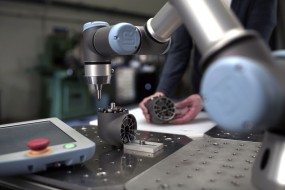Human-Robot Collaboration: Case Stories
The term ‘collaborative robot’ is used for those robots that detect the presence of other objects (humans or machines) working in the area and are programmed to prevent collisions and injury. In recent years, safety barriers to separate humans and robots have started to disappear as the new breed collaborative robot has entered the market and the safe features allow humans and robots to work together in more efficient and productive ways.
As one of the most prominent collaborative robot maker, Universal Robots entered the market with a new vision. When the industry is surrounded by big, heavy and expensive robots, they offer small and low-cost collaborative robotic arms with great precision, flexibility and programmability. These robot arms are not only simple and safe to operate but can also perform complex work alongside a human worker.
The Universal Robots collaborative robotic arms are being used in hundreds of production environments.
Case story 1: Everyone’s a robot expert
One of the largest sugar factories in Europe Nordic Sugar were looking for a new generation of robots to replace the old ones to automate the analysis of raw material samples. The most important criteria were flexible, user-friendly and low-cost.
The Universal Robots UR5 was tested in the sugar analysis process. The UR5 robots scan barcodes and pick up containers with sugar for analysis from scales to filters and back again. The process is performed by a pneumatic gripper and a barcode scanner integrated in the robot’s end-of-arm tool. As the robots require no safety guarding employees can work right alongside them – and no longer have to call expensive experts when they need to change a robot’s task.
The Universal Robots UR5 met every criteria and has enabled the employees to easily make process adjustments themselves instead of consulting robot experts.
Case story 2: Vision robots cuts production time by 9 hours
By having a UR5 robot tend four CNC machines milling dental crowns, Glidewell Laboratories in California was able to optimize a substantial part of the production cycle.
Producing the perfect crown is complicated process. It usually takes five days from when a dentist sends an impression of a patient’s teeth to the lab, until the finished crown returns. Glidewell Laboratories in Newport Beach, California, wanted to optimize this process.
The main challenge was a 10-minute milling cycle, which made it unfeasible to have an operator stationed at the machine. Instead, the lab manually inserted the crowns in batches of 15 each, which only needed to be done every two hours.
The engineering manager at Glidewell believed an intelligent automation solution could ensure a more fluent process and soon the company decided to try out a UR5 robot. It was easily programmed to pick a crown from the dispensers, place it in the milling lathe, pick it back out, and place it on a conveyor after the 10 minute milling cycle.

By communicating with a vision camera, the robot was programmed to move on to a different shade if dispensers run out, ensuring fluent production. Overall, this dynamic, single part flow has cut the production-cycle time from 28 to 17 hours, saving two milling operators per shift.
The company run a 24/7 operation and the robot has freed their employees up to focus on complex tasks, which improves the overall product quality.
RNA are agents in the UK for the Universal Robots range of collaborative robots and can now offer the latest addition to the Universal Robots range, the UR 3 collaborative robot, a true power tool perfect for small-format precision tasks.
Link: RNA Collaborative Robots